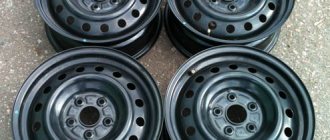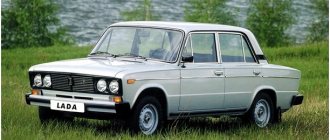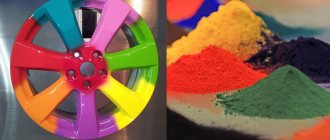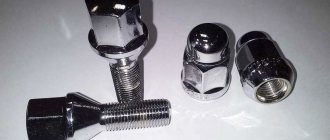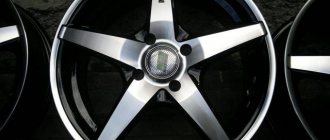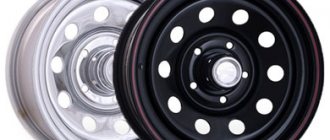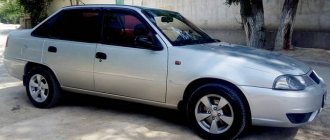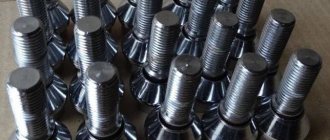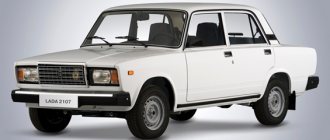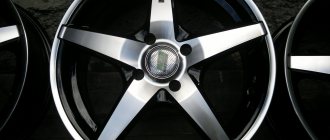Types of alloy wheels
All light alloy wheels are divided into two main groups.
- Alloy wheels are light alloy wheels that are made by hot casting, where molten metal is poured into molds. Therefore, cast wheels turn out to be quite fragile and do not have the proper elasticity. During impacts and collisions, impressive cracks and chips form on them, the geometry is disrupted and beating appears.
- Forged wheels are made differently. The light alloy blank is heated and stamped. As a result of metal drawing, the structure of the product becomes fibrous, which significantly increases the strength and reliability of the forged disk. Such wheels are less likely to crack and deform.
Why does rust appear on wheels?
The appearance of corrosion on any metal products is promoted by exposure to chemically active substances and moisture. While driving along the highway, car wheels come into contact with salt, water and various chemicals that are used to clear roads of ice in winter.
In addition, rust spreads very quickly over unprotected metal. On discs, such protection is provided by the paint coating and, if it is damaged, the appearance of corrosion processes is a matter of time. But it’s so easy to scratch your wheels in the same parking lot.
Types of discs and their susceptibility to corrosion
Different types of discs differ in material, configuration and processing technology, and therefore their resistance to corrosion is different. Discs are cast, stamped and forged.
Cast wheels are produced by pouring metal into a special mold, thermally hardening the finished part, and machining it. After which a paint layer and a protective coating are applied. The basis of such discs is aluminum and magnesium alloys, which resist corrosion quite well.
Stamped wheels are low cost and are most often installed on budget car brands. They are made from straight steel sheets. The disc itself consists of a rim and a circle connected to each other. They are most susceptible to corrosion, since the quality of painting on such discs is very low.
Forged wheels are very similar to their cast counterparts. They are manufactured by industrial stamping and hardening. They are expensive and quite resistant to rust.
Types of damage to alloy wheels
Car enthusiasts should be aware that it is unsafe to operate “problematic” alloy wheels. Currently, most problems are successfully resolved. Depending on the nature of the damage to the alloy wheel, the appropriate repair technology is selected.
The main types of damage to alloy wheels are:
- cracks,
- radial displacement,
- axial displacement,
- chips,
- damage to the paintwork.
Causes of damage to alloy wheels
In what driving situations do these problems appear?
- The cause of cracks on the casting surface is most often a strong impact when falling into a deep hole or pothole on the road. Wheels suffer especially badly when using low-profile tires.
- Radial runout (displacement) is formed when a wheel hits a high curb, as well as when it falls into a hole. In this case, a dent appears on the disk. This problem most often happens with “casting”.
- During axial runout, a “figure eight” appears, which is the result of a lateral impact of the cast disk on the curb. Similar damage occurs in a side collision with another vehicle.
- Chips and damage to the protective coating do not immediately destroy the alloy wheel. The effect of aggressive salt will appear in a couple of years, but then it will be too late to repair the disk.
What kind of damage to alloy wheels cannot be repaired?
Before contacting a specialized workshop that repairs alloy wheels, a motorist needs to know which casting problems become fatal. Not all car service workers will honestly and directly refuse to work in the event of serious breakdowns. Some will take advantage of the owner's naivety to gain profit. Therefore, in the absence of a reliable repairman, you should independently assess the condition of the disk.
Even the most experienced craftsmen, equipped with the latest equipment and devices, will not undertake to repair the following damage:
- wide and long cracks,
- cracks in the hub area,
- severe violation of geometric parameters,
- large chips.
What paint to paint the wheels
Modern car care products, including wheel rims, with constant use can maintain the color and integrity of the rim paint coating, but after a certain time, it is still better to repaint the rims completely, without spending additional costs on partial repairs of the coating.
For self-application of paintwork, conventional automotive paints and enamels and high-tech coatings are mainly used. Most often used for painting wheels:
- Acrylic paints;
- Nitro enamels;
- Liquid rubber.
- Powder paint.
Each type of coating is successfully used when painting wheel rims independently. However, when choosing the type of paint coating, it is necessary to take into account the properties of the paints and the features of the application technology.
Acrylic automotive enamels are the most common today and are widely used for painting body parts and rims. They are produced both in the form of ready-to-use compositions in aerosol cans, and in the form of separate color forms of paints that require further mixing to obtain the desired color. When dry, the paints form a durable film that is resistant to external influences. Painting with acrylic paints today is the most common and easiest type of work to master on your own. Acrylic-based paints are suitable for all types of discs.
Acrylic paint for car rims
The once popular nitro enamels are today used mainly in the form of aerosol cans. The popularity of this type of car paint lies in the ease and speed of work. The paints are sold ready-made, easy to apply to the surface, and dry quickly under normal conditions. This paint is usually used for express painting and is suitable for all types of rims. However, this paint holds up worse than others.
Nitro enamels for cars
Liquid rubber is a relatively new type of protective coating. The main form of release is ready-to-use paint in aerosol cans. It is easily applied to the surface, ensures reliable adhesion, and has excellent resistance to external influences. The downside of the paint is that it is difficult to select the required color, since it is sold in cans in a ready-made composition. Suitable for painting all types of discs.
Examples of liquid rubber colors
Powder paint is a new high-tech type of coating that provides reliable metal protection and at the same time excellent appearance. Powder paint makes it possible to create any color composition, including using several color transitions. The disadvantage of this dyeing technology is the need to use special equipment and great care when working. In addition, it is not recommended to use powder technology for application to light alloy cast wheels, especially from unknown manufacturers from the Middle Kingdom.
Powder paint
Methods for restoring and repairing alloy wheels
To solve problems associated with the repair of alloy wheels, the help of qualified specialists is required. You can only correct the protective coating with your own hands. Often, high-quality casting repairs require expensive equipment and tools, as well as the knowledge and skills of personnel.
- Any wheel rim undergoes a thorough inspection before repair. To do this, the inner and outer surface of the disk is cleaned of dirt. After this, you can detect even defects that are invisible at first glance.
- If cracks are detected, the cast disk is sent for argon welding. Cracks are sealed with a special electrode in an inert gas (argon) environment. For light alloy wheels based on aluminum, AG electrodes are used, and for repairing magnesium alloys, AMG electrodes are required.
- After welding, the disk is cleaned of sagging and splashes of molten metal.
- Now it is necessary to check the geometric characteristics of the casting, and, if necessary, correct them on a special machine. The disc is centered and mounted in a rotating chuck. Using a hydraulic cylinder with a set of attachments, the surface of the disk is straightened. As a result, the disk geometry is restored and radial and axial displacements are eliminated.
- Next, the surface of the cast disc is sanded, degreased, and a layer of acrylic or powder paint is applied. Parts coated with powder (paint) are sent to a polymerization chamber, where a durable protective layer is formed at high temperatures.
- All that remains is to check the balancing of the restored disk and make a final verdict. After repair, experts recommend installing some alloy wheels only on the rear axle.
Thanks to modern restoration technologies, many damage to alloy wheels can be successfully repaired. Important components of the complete restoration of casting performance will be the professionalism of service station workers and the availability of high-tech equipment.
Types of car wheel repairs
Modern equipment and the latest technologies allow our service specialists to perform the following types of repair and restoration of car rims:
- Rolling of stamped discs. It is relevant only for steel products and involves leveling the disc circumference on a special machine.
- Straightening of cast wheels. It is performed using professional equipment designed to correct the geometry of alloy wheels.
- Argon welding of discs. It is capable of completely restoring the integrity of the cast wheel and strengthening its strength in places of damage, eliminating the resulting defects and giving the wheel a pleasant appearance.
- Powder coating of wheels. It is very important for any disks after restoring their geometry as the final stage of repair. The paint can protect wheels from light mechanical damage and the adverse effects of precipitation and chemicals for a very long period.
Subaru Forester #atmostokrabochayaloshadka › Logbook › Do-it-yourself restoration of alloy wheels.
This is what the casting of the workhorse began to look like at the end of last winter. But the appearance somehow bothered me the least, since the wheels continued to perform their direct function properly... or almost. The problem is that due to the oxidation of aluminum, the tire no longer fits tightly to the rim and, accordingly, the logical result was a decent diffusion, which at first began to cause some inconvenience in the form of the need to inflate the wheel once a month, and then it was necessary to dismantle the wheel and clean the rim from corrosion results... Fortunately, winter had come to an end by this time and I happily installed a summer set of wheels.
The winter tires were immediately removed from the problem rims and the thinking began. By definition, there are few options here: restore these discs or buy another replacement casting. Moreover, in terms of finances, these options turned out to be almost identical. Well, this is if you buy not very sophisticated wheels. Having figured out that restoring disks is not very cheap, and the disks are far from exclusive, at first I wanted to throw them out and buy a replacement. But then I decided that it was somehow not sporty and decided to try to tinker with these pieces of iron. Mainly I was terribly curious what would happen in the end.
First of all, remove any remaining paint and varnish. Here the choice is obvious - sandblasting. The discs were returned safely and a few days later they returned in this form.
Looks noticeably more cheerful than before
